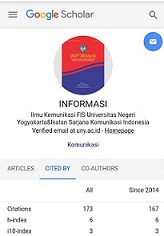Watching self from a distance: The whys of watching sinetrons among Malay-Javanese women in Malaysia
DOI:
https://doi.org/10.21831/informasi.v47i2.17377Keywords:
Television, Audience Ethnography, Cultural IdentityAbstract
This article discusses the cognitive reasoning behind the love for watching sinetron expressed by Malay-Javanese women in Malaysia. The Malay-Javanese women in this context refer to female members of Javanese communities within Malay society. Malaysians of Javanese descent are constitutionally considered as ethnic component of Malay racial group due to similarities in cultural customs and religion of Islam. However, they retain some semblance of Javanese cultural heritage including speaking the language in their everyday life. In the context of Malay-Javanese women under this study, it is identified that sinetrons have become the main source of their cultural consumption from television. Sinetrons are soap opera-like television productions from Indonesia"”the country where their ancestors were originated from. The results from ethnographic fieldwork in Kampung Papitusulem of Selangor show how these women incline to watching sinetrons to a certain level, primarily due to three main reasons. First, the dialogues in the television productions fit their language preference. Second, they can find representations of their cultural identity in the images of sinetrons. Third, they watch the imported television program from Indonesia simply for the identification of sense of belonging. It is argued that viewing sinetrons for these women represents watching self from a distance, which is central discussion in cultural and media studies.
Artikel ini membicarakan pemikiran kognitif di sebalik kecintaan menonton sinetron
dalam kalangan wanita Melayu-Jawa di Malaysia. Wanita Melayu-Jawa dalam konteks
ini merujuk pada warga perempuan dari komunitas Jawa dalam masyarakat Melayu.
Menurut Konstitusi Malaysia, warga negara Malaysia keturunan Jawa dianggap
sebagai komponen etnik dari kelompok bangsa Melayu karena memiliki kesamaan adat
budaya dan keyakinan sebagai Muslim. Pada hakikatnya, mereka masih mengekalkan
beberapa komponen warisan budaya Jawa seperti penggunaan Bahasa Jawa dalam
keseharian mereka. Dalam konteks wanita Melayu-Jawa yang dibahas dalam artikel ini,
diketahui bahwa sinetron telah menjadi salah satu sumber budaya termediakan oleh
televisi yang mengeratkan pertalian dengan asal usul mereka. Sinetron merupakan
produksi televisi yang tergolong genre opera sabun berasal dari Indonesia"”negara
yang menjadi tanah kelahiran pendahulu wanita tersebut. Hasil dari kerja lapangan
etnografi, di Kampung Papitusulem, Selongor, menunjukan bagaimana wanita-wanita
ini menyukai sinetron pada tahap tertentu karena tiga alasan utama. Pertama, dialog
yang digunakan dalam sinetron sesuai dengan preferensi mereka. Kedua, mereka dapat
menemukan identifikasi identitas budaya mereka dalam representasi sinetron. Ketiga,
mereka menonton program televisi yang diimport dari Indonesia sebagi ekspresi rasa
memiliki terhadap Indonesia. Ini menunjukkan bahwa menonton sinetron bagi wanita
Melayu-Jawa mempunyai makna seperti melihat identitas diri dari kejauhan, dan ini
merupakan diskusi sentral dalam kajian media dan budaya.
References
Abu-Lughod, L. (1997). The interpretation of culture(s) after television. Representations, (59), 109-134.
Adriaens, F. (2014). Diaspora girls doing identities: Creating ideal television programmes and narratives of the self. European Journal of Cultural Studies, 17(2), 101-117.
Andaya, B. W., & Andaya, L. Y. (2001). A history of Malaysia (2nd ed.). Hampshire: Palgrave.
Barker, C. (1999). Television, globalization and cultural identities. Berkshire: Open University Press.
Castelló, E. (2009). The nation as political stage: A theoretical approach to television fiction and national identity. International Communication Gazette 71(4), 303–322.
Coover, G. E. (2001). Television and social identity: Race representation as "White" accommodation. Journal of Broadcasting & Electronic Media, 45(3), 413-431.
Fetterman, D. M. (2010). Ethnography: Step-by-step. Thousand Oaks: Sage
Fish, S. (1980). Is there a text in this class? The authority of interpretive communities. Cambridge: Harvard University Press.
Fiske, J. (2011). Reading the popular (2nd ed.). Abingdon: Routledge
Geertz, C. (1976). The religion of Java. Chicago: University of Chicago Press.
Giddens, A. (1984). The constitution of society: Outline of the theory of structuration. Berkeley: University of California Press.
Giddens, A. (1991). Modernity and self-identity: Self and society in the late modern age. Stanford: Stanford University Press.
Gobo, G. (2008). Doing ethnography. London: Sage.
Guest, G., MacQueen, K. M, and Namey, E. E. (2012) Applied thematic analysis. Thousand Oaks: Sage.
Hall, S. (1996). "Who needs "˜identity'?" In S. Hall & P. Du Gay (Eds.), Questions of cultural identity (pp. 1-17). London: Sage.
Harwood, J. (1997). Viewing age: Lifespan identity and television viewing choices. Journal of Broadcasting & Electronic Media, 41(2), 203-213.
Kahn, J. S. (2006). Other Malays: Nationalism and cosmopolitanism in the modern Malay world. Singapore: NUS Press.
La Pastina A. C. (2004). Telenovela reception in rural Brazil: Gendered readings and sexual mores. Critical Studies in Media Communication, 21(2), 162-181, doi: 10.1080/07393180410001688056
Lindlof, T. R. (2002). Interpretive community: An approach to media and religion. Journal of Media and Religion, 1(1), 61-74. doi: 10.1207/s15328415jmr0101_7
Livingstone, S. (1998). Making sense of television: The psychology of audience interpretation (2nd ed.). London: Routledge.
Louie, J. K. Y. (2006). Television, ethnic identity, and race: The views of Chinese Youth from immigrant families (Doctoral thesis). Available from ProQuest Dissertations & Theses. (UMI No. 3221638)
Mankekar, P. (1993). National texts and gendered lives: An ethnography of television viewers in a North Indian City. American Ethnologist, 20(3), 543-563.
Mankekar, P. (2002). Epic contests: Television and religious identity in India. In F. D. Ginsburg, L. Abu-Lughod, & B. Larkin (Eds.), Media worlds: Anthropology on new terrain (pp. 134-151). Berkeley: University of California Press.
McMillin, D., & Fisherkeller, J. (2009). Local identities in globalized regions: teens, everyday life, and television. Popular Communication, 7(4), 237-251. 10.1080/15405700903221343
Milner, A. (2002). The invention of politics in colonial Malaya: Contesting nationalism and the expansion of the public sphere. Cambridge: Cambridge University Press.
Price, M. E. (1995). Television, the public sphere, and national identity. Oxford: Oxford University Press.
Reid, A. (2001). Understanding Melayu (Malay) as a source of diverse modern identities. Journal of Southeast Asian Studies, 32(3), 295-313. doi: 10.2307/20072348
Rofil, L. E. F. (2016). Television consumption and the construction of hybrid identity among female descendants in Malaysia (Doctoral thesis). University of Malaya, Kuala Lumpur, Malaysia.
Roussou, N. (2002). Research note: Television, cultural identity and youth lifestyles in Cyprus: Secure moorings in a shifting world?. European Journal of Communication, 17(3), 355-367.
Scrase, T. J. (2002). Television, the middle classes and the transformation of cultural identities in West Bengal, India. International Communication Gazette, 64(4), 323-343.
Shamsul A. B. (1997). The economic dimension of Malay nationalism: The socio historical roots of the new economic policy and its contemporary implications. The Developing Economies, 35(3), 240-261.
Shetty, M. L. (2008). Television and the construction of Tulu identity in South India (Doctoral thesis). Retrieved from ProQuest Dissertations and Theses. (3341959)
Thompson, E. C. (2000). In K.L.-and-kampung: Urbanism in rural Malaysia (Doctoral thesis). Available from ProQuest Dissertations & Theses. (UMI No. 9983558)
Thompson, K. (2002). Border crossings and diasporic identities: Media use and leisure practices of an ethnic minority. Qualitative Sociology 25(3), 409-418.
Tinic, S. (2006). Global vistas and local reflections negotiating place and identity in Vancouver television. Television & New Media, 7(2), 154-183.
Tuchman, G. (1994). Realism and romance: The study of media effects. In M. R. Levy & M. Gurevitch (Eds.), Defining media studies: Reflections on the future of the field (pp. 278-283). New York: Oxford University Press.
Tuchman, G. (1994). Realism and romance: The study of media effects. In M. R. Levy & M. Gurevitch (Eds.), Defining media studies: Reflections on the future of the field (pp. 278-283). New York: Oxford University Press.
Turner, G. (2005). Cultural identity, soap narrative, and reality TV. Television & New Media, 6(4), 415-422. doi: 10.1177/1527476405279864
Vickers, A. (2004). "˜Malay identity': Modernity, invented tradition and forms of knowledge. In T. P. Barnard (Ed.), Contesting Malayness: Malay Identity across boundaries (pp. 25-55). Singapore: Singapore University Press.
Yeoh, C. R. (2006). Malaysia, truly Asia? Religious pluralism in Malaysia. The Pluralism Project–Research Report, 42. Retrieved from http://www.pluralism.org/reports/view/42.
Downloads
Published
Issue
Section
License
Authors who publish with this journal agree to the following terms:- Authors retain copyright and grant the journal right of first publication with the work simultaneously licensed under a Creative Commons Attribution License that allows others to share the work with an acknowledgement of the work's authorship and initial publication in this journal.
- Authors are able to enter into separate, additional contractual arrangements for the non-exclusive distribution of the journal's published version of the work (e.g., post it to an institutional repository or publish it in a book), with an acknowledgement of its initial publication in this journal.
- Authors are permitted and encouraged to post their work online (e.g., in institutional repositories or on their website) prior to and during the submission process, as it can lead to productive exchanges, as well as earlier and greater citation of published work (See The Effect of Open Access).





















